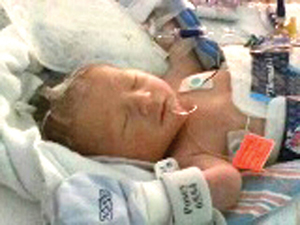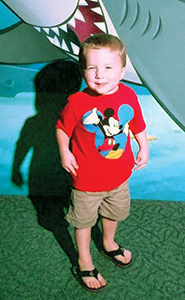By ELLEN FRANCIS HARRIS
Samantha Latimer kept pushing. Her baby couldn't emerge because the umbilical cord was wrapped so tightly around his neck that it kept pulling him back. When the obstetrician delivered him, the newborn was a bluish white color. He was not breathing.
"I couldn't hear any crying," Latimer said. "There was absolutely nothing. It was the scariest moment of my life. I heard them call 'code blue.'" Doctors and nurses came running into the delivery room at St. Joseph's Women's Hospital, in Tampa, Fla., that day, Nov. 13, 2012.
"I looked at my mother, and she ran out of the room. I looked at my husband, John. His eyes had filled with tears. I asked, 'Is our baby dead?'
"Then I heard a whimper. The doctors took him away, and I didn't see him or hold him," Latimer said.
A few hours later, the Latimers went to the neonatal intensive care unit where their firstborn, named Titan, lay hooked to a ventilator. He was wrapped inside a therapeutic hypothermic cooling blanket connected to a portable machine. Titan Latimer was the first to use the newborn cooling blanket program at St. Joseph's.
Timing is critical. "For the cooling blanket to work, we have only a six-hour window to initiate the process. It may be even better if we can start within three hours after birth," said Dr. Alfonso Vargas, a neonatologist with Pediatrix Medical Group, who cared for Titan at St. Joseph's.
"Won't Titan be chilled? Won't this make him ill?" his mother asked Vargas.

To arrest inflammation that could damage his brain, newborn Titan Latimer is wrapped in a hypothermic cooling blanket in the neonatal intensive care unit at St. Joseph’s Women’s Hospital in Tampa, Fla.
"No, the baby doesn't feel very cold to the touch. Therapeutic hypothermia is such a shift from (our) normal way of thinking," Vargas said. "Our intuition and training for newborns is to keep them dry and warm. But under very controlled circumstances, we drop the infant's temperature to 92 degrees. The cold arrests inflammation and other damage to the brain from lack of oxygen." The process is called neuroprotection.
When Vargas arrived at St. Joseph's in July 2011, there was no cooling program for newborns. More and more NICUs around the country had instituted cooling programs for babies after large clinical trials showed that at-risk infants have a better rate of survival and lower rates of long-term disability when they are cooled. The medical establishment recommended cooling be offered to babies with brain injuries or potential ones.
Vargas and his team developed their program and began cooling babies in November 2012. St. Joseph's Women's Hospital became the third hospital in the Tampa Bay area to use the program with infants.
Born at 35 1/2 weeks, Titan was classified as premature although he weighed 6 pounds and 9 ounces. His distress at birth made him a good candidate for cooling.
"If the baby suffers a mild to moderate injury, cooling works very well," Vargas said. "But cooling doesn't help so much for severe injuries. Cooling prevents more brain cells from dying. But we cannot recover dead brain cells. We are very careful who we pick to cool."

Now an active, healthy 2-year-old, Titan Latimer was put into a hypothermic state in the neonatal intensive care unit at St. Joseph’s Women’s Hospital in Tampa, Fla., immediately after his birth.
Latimer said, "Titan was chosen because they were afraid he'd have cerebral palsy because they didn't know how long he was without oxygen."
Controlled cool down
"Once a newborn meets the criteria, we insert a rectal probe that measures his internal core temperature several times a minute," Vargas said. "It's connected to the machine that continuously controls the blanket. Then we wrap him in the cooling blanket. If he becomes warmer, the machine sends cooler water into the blanket to cool him down. And vice versa, if his temperature goes too low. We don't want the newborn to deviate from that 92 degrees for 72 hours. Then we slowly warm him back up over six to eight hours. The machine does all the thinking for us while our special team of NICU physicians, nurses and respiratory therapists monitor his condition," Vargas said.
One-on-one
"While the baby is being cooled, one nurse is assigned to him. They work one-on-one because it's too demanding for a nurse to handle more than one child at a time," Vargas said. "Working in the NICU is very intensive for our nurses. It's physically, emotionally and mentally demanding. If the baby doesn't make it, we feel like we've lost our baby, too. A nurse spends so much time at the bedside, she really loves those infants. It's a unique caregiver relationship."
Once Titan's body temperature reached the target, the nurses removed his cooling blanket and his parents held him. "John cried, I cried, we were so happy," Latimer said. "That was the best feeling of my entire life — being able to hold him."
About 12 to 15 babies are treated using cooling blankets at St. Joseph's every year. Of the 7,500 babies annually delivered at St. Joseph's, five to six babies will need cooling. Another six to nine infants arrive by ambulance or helicopter from other facilities that do not offer cooling. St. Joseph's can send an ambulance or helicopter to a rural area with a portable CritiCool machine and the hospital's neonatal pediatric transport team of nurses and respiratory therapists. Team members initiate the process of cooling the newborn.
Surpassing expectations
"We can make a difference in a baby's life," Vargas said. "Sometimes, we are looking at a severely injured baby with a very low chance of survival and permanent brain damage even if he survives. We cool them and treat them in the NICU and sometimes they far exceed our expectations. It's really a miracle.
"Looking at a photo of Titan on a cooling blanket with a ventilator and tubes and then seeing him running around as a healthy two-year-old, it's hard to believe that's the same child," Vargas said. "To know that a kid like Titan is thriving is one of the most rewarding things to see," Vargas said.
Indeed. At 23 months, Titan weighed 27 pounds and stood 34 1/2 inches tall. "My husband and I are so grateful that Titan was placed on the cooling blanket, and it changed our lives forever," Samantha Latimer said.
Criteria for cooling babies
Not every distressed newborn is a candidate for therapeutic hypothermia. Neonatologists look for a newborn:
- who weighs at least 1,800 grams (about 4 pounds).
- who reached at least 35 weeks of gestation. If the baby is smaller than
4 pounds or earlier than 35 weeks, cooling could be harmful. - who has some abnormality such as seizures, low muscle tone, breathing difficulty.
- who suffered placental abruption, a detached placenta which causes hemorrhaging. The baby does not get enough blood to the brain and can suffer shock.
- whose mother has suffered from eclampsia seizure, which compromises the blood flow to the uterus.
- who days after birth has a seizure or hemorrhage or heart problem or is injured, all of which can interrupt the flow of blood and oxygen to the brain.
Copyright © 2015 by the Catholic Health Association
of the United States
For reprint permission, contact Betty Crosby or call (314) 253-3477.